Spatio-Temporal Dynamics of Particulate Organic Carbon and Its Response to Climate Change: Evidence of the East China Sea from 2003 to 2022
Abstract
1. Introduction
2. Materials and Methods
2.1. Overview of the Study Area
2.2. Research Data
2.3. Research Methodology
3. Results
3.1. The Interannual Variation Characteristics of Particulate Organic Carbon Concentration
3.2. The Monthly Variation Characteristics of Particulate Organic Carbon Concentration
3.3. Correlation Analysis of Influencing Factors of Particulate Organic Carbon Concentration
4. Discussion
4.1. The Drivers of Interannual Variability in POC Concentration
4.2. The Factors Contributing to Inter-Monthly Variations in POC Concentration
4.3. Analysis of the Influencing Factors on POC Concentration
4.4. Implications for Marine Carbon Management Under Climate Change
5. Conclusions
Author Contributions
Funding
Data Availability Statement
Conflicts of Interest
References
- DeVries, T. The ocean carbon cycle. Annu. Rev. Environ. Resour. 2022, 47, 317–341. [Google Scholar] [CrossRef]
- Wang, S.-J.; Cao, L.; Li, N. Responses of the ocean carbon cycle to climate change: Results from an earth system climate model simulation. Adv. Clim. Change Res. 2014, 5, 123–130. [Google Scholar] [CrossRef]
- Wang, A.; Zhang, M.; Chen, E.; Zhang, C.; Han, Y. Impact of seasonal global land surface temperature (LST) change on gross primary production (GPP) in the early 21st century. Sustain. Cities Soc. 2024, 110, 105572. [Google Scholar] [CrossRef]
- Kong, L.-F.; He, Y.-B.; Xie, Z.-X.; Luo, X.; Zhang, H.; Yi, S.-H.; Lin, Z.-L.; Zhang, S.-F.; Yan, K.-Q.; Xu, H.-K.; et al. Illuminating key microbial players and metabolic processes involved in the remineralization of particulate organic carbon in the ocean’s twilight zone by metaproteomics. Appl. Environ. Microbiol. 2021, 87, AEM0098621. [Google Scholar] [CrossRef] [PubMed]
- Li, H.; Feng, X.; Xiong, T.; Shao, W.; Wu, W.; Zhang, Y. Particulate organic carbon released during macroalgal growth has significant carbon sequestration potential in the ocean. Environ. Sci. Technol. 2023, 57, 19723–19731. [Google Scholar] [CrossRef]
- Xiu, P.; Chai, F. Impact of Atmospheric deposition on carbon export to the deep ocean in the subtropical northwest pacific. Geophys. Res. Lett. 2021, 48, 640. [Google Scholar] [CrossRef]
- Boscolo-Galazzo, F.; Crichton, K.A.; Ridgwell, A.; Mawbey, E.M.; Wade, B.S.; Pearson, P.N. Temperature controls carbon cycling and biological evolution in the ocean twilight zone. Science 2021, 371, 1148–1152. [Google Scholar] [CrossRef]
- Pan, Y.; Li, Y.; Chen, C.-T.A.; Jiang, Z.-P.; Cai, W.-J.; Shen, Y.; Ding, Z.; Chen, Q.; Di, Y.; Fan, W.; et al. New pathway of diatom-mediated calcification and its impact on the biological pump. Sci. Bull. 2023, 68, 2540–2543. [Google Scholar] [CrossRef]
- Lv, M.; Wang, F.; Li, Y. Eddy-Induced Subsurface Spiciness Anomalies in the Kuroshio Extension Region. J. Phys. Oceanogr. 2023, 53, 2893–2912. [Google Scholar] [CrossRef]
- Chen, D.; Zeng, L.; Boot, K.; Liu, Q. Satellite observed spatial and temporal variabilities of particulate organic carbon in the east China sea. Remote Sens. 2022, 14, 1799. [Google Scholar] [CrossRef]
- Stramska, M.; Stramski, D. Variability of particulate organic carbon concentration in the north polar Atlantic based on ocean color observations with Sea-viewing Wide Field-of-view Sensor (SeaWiFS). J. Geophys. Res. Oceans 2005, 110, 2762. [Google Scholar] [CrossRef]
- Stramski, D.; Reynolds, R.A.; Babin, M.; Kaczmarek, S.; Lewis, M.R.; Röttgers, R.; Sciandra, A.; Stramska, M.; Twardowski, M.S.; Franz, B.A.; et al. Relationships between the surface concentration of particulate organic carbon and optical properties in the eastern South Pacific and eastern Atlantic Oceans. Biogeosciences 2008, 5, 171–201. [Google Scholar] [CrossRef]
- Allison, D.B.; Stramski, D.; Mitchell, B.G. Empirical ocean color algorithms for estimating particulate organic carbon in the Southern Ocean. J. Geophys. Res. Oceans 2010, 115, 6040. [Google Scholar] [CrossRef]
- Hu, S.; Cao, W.; Wang, G.; Xu, Z.; Zhao, W.; Lin, J.; Zhou, W.; Yao, L. Empirical ocean color algorithm for estimating particulate organic carbon in the South China Sea. Chin. J. Oceanol. Limnol. 2015, 33, 764–778. [Google Scholar] [CrossRef]
- Zhao, Z.; Cai, X.; Huang, C.; Shi, K.; Li, J.; Jin, J.; Yang, H.; Huang, T. A novel semianalytical remote sensing retrieval strategy and algorithm for particulate organic carbon in inland waters based on biogeochemical-optical mechanisms. Remote Sens. Environ. 2022, 280, 113213. [Google Scholar] [CrossRef]
- Liu, S.; Cai, D.; Zhao, T.; Li, J.; Wu, L. Study on the spatiotemporal variation characteristics of POC concentration in the South China Sea based on satellite remote sensing. Meteorol. Sci. Technol. 2023, 51, 134–141. [Google Scholar]
- Kong, C.E.; Sathyendranath, S.; Jackson, T.; Stramski, D.; Brewin, R.J.W.; Kulk, G.; Jönsson, B.F.; Loisel, H.; Galí, M.; Le, C. Comparison of ocean-colour algorithms for particulate organic carbon in global ocean. Front. Mar. Sci. 2024, 11, 1309050. [Google Scholar] [CrossRef]
- Liu, Z.; Gan, J.; Hu, J.; Wu, H.; Cai, Z.; Deng, Y. Progress on circulation dynamics in the East China Sea and southern Yellow Sea: Origination, pathways, and destinations of shelf currents. Prog. Oceanogr. 2021, 193, 102553. [Google Scholar] [CrossRef]
- Cai, S.; Wu, M.; Le, C. Satellite Observation of the Long-Term Dynamics of Particulate Organic Carbon in the East China Sea Based on a Hybrid Algorithm. Remote Sens. 2022, 14, 3220. [Google Scholar] [CrossRef]
- Seo, J.; Kim, G.; Hwang, J. Sources and behavior of particulate organic carbon in the yellow sea and the east China sea based on 13C, 14C, and 234Th. Front. Mar. Sci. 2022, 9, 793556. [Google Scholar] [CrossRef]
- Zhao, L.; Gao, L. Dynamics of dissolved and particulate organic matter in the Changjiang (Yangtze River) Estuary and the adjacent East China Sea shelf. J. Mar. Syst. 2019, 198, 103188. [Google Scholar] [CrossRef]
- Wang, X.; Yu, J.; Fan, H. Spatial and seasonal variability of surface particulate inorganic carbon and relationship with particulate organic carbon in the Yellow-Bohai Sea. J. Oceanogr. 2020, 76, 327–339. [Google Scholar] [CrossRef]
- Hung, C.-C.; Tseng, C.-W.; Gong, G.-C.; Chen, K.-S.; Chen, M.-H.; Hsu, S.-C. Fluxes of particulate organic carbon in the East China Sea in summer. Biogeosciences 2013, 10, 6469–6484. [Google Scholar] [CrossRef]
- Shi, Y.; Zhang, T.; Zhang, C.; Cheng, J. Spatial and temporal distribution of particulate organic carbon in Yellow Sea and East China Sea. Mar. Environ. Sci. 2011, 30, 1–6. [Google Scholar]
- Xie, F.; Tao, Z.; Zhou, X.; Lv, T.; Wang, J. Spatial and Temporal Variations of Particulate Organic Carbon Sinking Flux in Global Ocean from 2003 to 2018. Remote Sens. 2019, 11, 2941. [Google Scholar] [CrossRef]
- Graff, J.R.; Nelson, N.B.; Roca-Martí, M.; Romanelli, E.; Kramer, S.J.; Erickson, Z.; Cetinić, I.; Buesseler, K.O.; Passow, U.; Zhang, X.; et al. Reconciliation of total particulate organic carbon and nitrogen measurements determined using contrasting methods in the North Pacific Ocean as part of the NASA EXPORTS field campaign. Elementa Sci. Anthr. 2023, 11, 112. [Google Scholar] [CrossRef]
- Puigcorbé, V.; Masqué, P.; Le Moigne, F.A.C. Global database of ratios of particulate organic carbon to thorium-234 in the ocean: Improving estimates of the biological carbon pump. Earth Syst. Sci. Data 2020, 12, 1267–1285. [Google Scholar] [CrossRef]
- Melet, A.; Teatini, P.; Le Cozannet, G.; Boschi, L.; Ciarletti, V.; D’Alpaos, A.; Feyen, L.; Gauer, P.; Marani, M.; Stumpf, R.P. Earth Observations for Monitoring Marine Coastal Hazards and Their Drivers. Surv. Geophys. 2020, 41, 1489–1534. [Google Scholar] [CrossRef]
- Wang, F.; Li, X.; Tang, X.; Wu, L.; Liu, Q.; Zhao, M.; Liu, Z. The seas around China in a warming climate. Nat. Rev. Earth Environ. 2023, 4, 535–551. [Google Scholar] [CrossRef]
- Wang, Z.; Yuan, C.; Zhang, X.; Liu, Y.; Fu, M.; Xiao, J. Interannual variations of Sargassum blooms in the Yellow Sea and East China Sea during 2017–2021. Harmful Algae 2023, 126, 102451. [Google Scholar] [CrossRef]
- Zhang, M.; Sun, X.; Hu, Y.; Chen, G.; Xu, J. The influence of anthropogenic activities on heavy metal pollution of estuary sediment from the coastal East China Sea in the past nearly 50 years. Mar. Pollut. Bull. 2022, 181, 113872. [Google Scholar] [CrossRef]
- Cong, P.; Qu, L.; Han, G.; Yang, X. Remotely sensed detection and application analysis of ocean particulate organic carbon. Mar. Environ. Sci. 2012, 31, 300–304. [Google Scholar]
- Sun, J. Organic carbon pump and carbonate counter pump of living coccolithophorid. Adv. Earth Sci. 2007, 22, 1231–1239. [Google Scholar]
- National Earth System Science Data Center, National Science & Technology Infrastructure of China. Earth System Science Data [Dataset]. 2025. Available online: http://www.geodata.cn (accessed on 9 July 2024).
- Lin, T.; He, Q.; Zhan, W.; Zhan, H. Persistent data gap in ocean color observations over the East China Sea in winter: Causes and reconstructions. Remote Sens. Lett. 2020, 11, 667–676. [Google Scholar] [CrossRef]
- Moon, J.; Lee, K.; Lim, W.; Lee, E.; Dai, M.; Choi, Y.; Han, I.; Shin, K.; Kim, J.; Chae, J. Anthropogenic nitrogen is changing the East China and Yellow seas from being N deficient to being P deficient. Limnol. Oceanogr. 2021, 66, 914–924. [Google Scholar] [CrossRef]
- He, X.; Bai, Y.; Pan, D.; Chen, C.-T.A.; Cheng, Q.; Wang, D.; Gong, F. Satellite views of the seasonal and interannual variability of phytoplankton blooms in the eastern China seas over the past 14 yr (1998–2011). Biogeosciences 2013, 10, 4721–4739. [Google Scholar] [CrossRef]
- Franklin, J.B.; Sathish, T.; Vinithkumar, N.V.; Kirubagaran, R. A novel approach to predict chlorophyll-a in coastal-marine ecosystems using multiple linear regression and principal component scores. Mar. Pollut. Bull. 2020, 152, 110902. [Google Scholar] [CrossRef] [PubMed]
- R Core Team. R: A Language and Environment for Statistical Computing; R Foundation for Statistical Computing: Vienna, Austria, 2023. [Google Scholar]
- Hu, C.; Feng, L.; Lee, Z.; Franz, B.A.; Bailey, S.W.; Werdell, P.J.; Proctor, C.W. Improving satellite global chlorophyll a data products through algorithm refinement and data recovery. J. Geophys. Res. Oceans 2019, 124, 1524–1543. [Google Scholar] [CrossRef]
- Adames, A.F.; Reynolds, M.; Smirnov, A.; Covert, D.S.; Ackerman, T.P. Comparison of Moderate Resolution Imaging Spectroradiometer ocean aerosol retrievals with ship-based Sun photometer measurements from the Around the Americas expedition. J. Geophys. Res. 2011, 116, 440. [Google Scholar] [CrossRef]
- Kilpatrick, K.A.; Podestá, G.P.; Evans, R. Overview of the NOAA/NASA advanced very high resolution radiometer Pathfinder algorithm for sea surface temperature and associated matchup database. J. Geophys. Res. Space Phys. 2001, 106, 9179–9197. [Google Scholar] [CrossRef]
- Patt, F.S. SeaWiFS Postlaunch Technical Report Series, Volume 22, Algorithm Updates for the Fourth SeaWiFS Data Reprocessing (NASA Tech. Rep. No. NASA/TM-2003-212299); National Aeronautics and Space Administration: Greenbelt, MD, USA, 2003. [Google Scholar]
- Hung, C.-C.; Chen, Y.-F.; Hsu, S.-C.; Wang, K.; Chen, J.F.; Burdige, D.J. Using rare earth elements to constrain particulate organic carbon flux in the East China Sea. Sci. Rep. 2016, 6, 33880. [Google Scholar] [CrossRef]
- Wang, J.; Xu, C. Geodetector: Principle and prospective. Acta Geogr. Sin. 2017, 72, 116–134. [Google Scholar]
- Doney, S.C.; Ruckelshaus, M.; Duffy, J.E.; Barry, J.P.; Chan, F.; English, C.A.; Galindo, H.M.; Grebmeier, J.M.; Hollowed, A.B.; Knowlton, N.; et al. Climate change impacts on marine ecosystems. Annu. Rev. Mar. Sci. 2012, 4, 11–37. [Google Scholar] [CrossRef] [PubMed]
- Liu, M.; Raymond, P.A.; Lauerwald, R.; Zhang, Q.; Trapp-Müller, G.; Davis, K.L.; Moosdorf, N.; Xiao, C.; Middelburg, J.J.; Bouwman, A.F.; et al. Global riverine land-to-ocean carbon export constrained by observations and multi-model assessment. Nat. Geosci. 2024, 17, 896–904. [Google Scholar] [CrossRef]
- Zhang, S.; Yager, P.L.; Liang, C.; Shen, Z.; Xian, W. Distribution and spatial-temporal variation of organic matter along the Yangtze River-ocean continuum. Elementa Sci. Anthr. 2022, 10, 34. [Google Scholar] [CrossRef]
- Fang, F.-T.; Zhu, Z.-Y.; Ge, J.-Z.; Deng, B.; Du, J.-Z.; Zhang, J. Reconstruction of the main phytoplankton population off the Changjiang Estuary in the East China Sea and its assemblage shift in recent decades: From observations to simulation. Mar. Pollut. Bull. 2022, 178, 113638. [Google Scholar] [CrossRef]
- Zhong, Q.; Huang, D.; Wang, Q.; Li, J.; Li, X.; Liu, S. Terrestrial and marine POC export fluxes estimated by 234Th–238U disequilibrium and δ13C measurements in the East China Sea shelf. Biogeochemistry 2024, 167, 807–827. [Google Scholar] [CrossRef]
- Cai, H.; Zhang, X.; Zhang, M.; Guo, L.; Liu, F.; Yang, Q. Impacts of Three Gorges Dam’s operation on spatial–temporal patterns of tide–river dynamics in the Yangtze River estuary, China. Ocean. Sci. 2019, 15, 583–599. [Google Scholar] [CrossRef]
- Wang, X.; Ma, H.; Li, R.; Song, Z.; Wu, J. Seasonal fluxes and source variation of organic carbon transported by two major Chinese Rivers: The Yellow River and Changjiang (Yangtze) River. Glob. Biogeochem. Cycles 2012, 26, 4130. [Google Scholar] [CrossRef]
- Xu, Z.; Ma, J.; Wang, H.; Hu, Y.; Yang, G.; Deng, W. River discharge and saltwater intrusion level study of yangtze river estuary, China. Water 2018, 10, 683. [Google Scholar] [CrossRef]
- Liu, D.; Bai, Y.; He, X.; Tao, B.; Pan, D.; Chen, C.-T.A.; Zhang, L.; Xu, Y.; Gong, C. Satellite estimation of particulate organic carbon flux from Changjiang River to the estuary. Remote Sens. Environ. 2019, 223, 307–319. [Google Scholar] [CrossRef]
- Xu, W.; Wang, G.; Jiang, L.; Cheng, X.; Zhou, W.; Cao, W. Spatiotemporal variability of surface phytoplankton carbon and carbon-to-chlorophyll a ratio in the South China Sea based on satellite data. Remote Sens. 2020, 13, 30. [Google Scholar] [CrossRef]
- Farfán, L.M.; D’sa, E.J.; Liu, K.-B.; Rivera-Monroy, V.H. Tropical cyclone impacts on coastal regions: The case of the Yucatán and the Baja California Peninsulas, Mexico. Estuaries Coasts 2014, 37, 1388–1402. [Google Scholar] [CrossRef]
- Shi, H.; Chen, Y.; Gao, H.; Zhao, H. Effects of typhoon and upwelling on Chlorophyll-a distribution in the northeastern coast of Hainan during Summer. PLoS ONE 2023, 18, e0284689. [Google Scholar] [CrossRef]
- Cavan, E.L.; Henson, S.A.; Boyd, P.W. The sensitivity of subsurface microbes to ocean warming accentuates future declines in particulate carbon export. Front. Ecol. Evol. 2019, 6, 230. [Google Scholar] [CrossRef]
- Wang, H.; Li, Y.; Li, Y.; Liu, H.; Wang, W.; Zhang, P.; Fohrer, N.; Li, B.-L.; Zhang, Y. Phytoplankton Communities’ Response to Thermal Stratification and Changing Environmental Conditions in a Deep-Water Reservoir: Stochastic and Deterministic Processes. Sustainability 2024, 16, 3058. [Google Scholar] [CrossRef]
- Resplandy, L.; Lévy, M.; McGillicuddy, D.J. Effects of eddy-driven subduction on ocean biological carbon pump. Glob. Biogeochem. Cycles 2019, 33, 1071–1084. [Google Scholar] [CrossRef]
- Dobashi, R.; Ueno, H.; Matsudera, N.; Saito, H.; Sato, Y.; Tsuji, T. Impact of mesoscale eddies on particulate organic carbon flux in the western subarctic North Pacific. J. Oceanogr. 2022, 78, 1–14. [Google Scholar] [CrossRef]
- Guerreiro, C.V.; Ferreira, A.; Cros, L.; Stuut, J.-B.; Baker, A.; Tracana, A.; Pinto, C.; Veloso, V.; Rees, A.P.; Cachão, M.A.P.; et al. Response of coccolithophore communities to oceanographic and atmospheric processes across the North- and Equatorial Atlantic. Front. Mar. Sci. 2023, 10, 1119488. [Google Scholar] [CrossRef]
- Sun, L.; Jin, X.; Su, X.; Liu, C. Coccolithophore carbonate counter pump covaried with ocean carbon cycle changes during the Mid-Miocene. Sci. Bull. 2024, 70, 600–603. [Google Scholar] [CrossRef]
- Naselli-Flores, L.; Padisák, J. Ecosystem services provided by marine and freshwater phytoplankton. Hydrobiologia 2023, 850, 2691–2706. [Google Scholar] [CrossRef] [PubMed]
- Yao, L.; Wang, X.; Zhang, J.; Yu, X.; Zhang, S.; Li, Q. Prediction of sea surface chlorophyll-a concentrations based on deep learning and time-series remote sensing data. Remote Sens. 2023, 15, 4486. [Google Scholar] [CrossRef]
- Omand, M.M.; D’asaro, E.A.; Lee, C.M.; Perry, M.J.; Briggs, N.; Cetinić, I.; Mahadevan, A. Eddy-driven subduction exports particulate organic carbon from the spring bloom. Science 2015, 348, 222–225. [Google Scholar] [CrossRef]
- Khan, M.A.; Kumar, S.; Roy, R.; Prakash, S.; Lotliker, A.A.; Baliarsingh, S.K. Tidal scale dissolved inorganic and particulate organic carbon dynamics in a tropical estuary. Mar. Chem. 2024, 267, 104451. [Google Scholar] [CrossRef]
- Golder, R.; Shuva, S.H.; Rouf, M.A.; Uddin, M.M.; Bristy, S.K.; Bir, J. Chlorophyll-a, SST and particulate organic carbon in response to the cyclone Amphan in the Bay of Bengal. J. Earth Syst. Sci. 2021, 130, 157. [Google Scholar] [CrossRef]
- Osterholz, H.; Burmeister, C.; Busch, S.; Dierken, M.; Frazão, H.C.; Hansen, R.; Jeschek, J.; Kremp, A.; Kreuzer, L.; Sadkowiak, B.; et al. Nearshore dissolved and particulate organic matter dynamics in the Southwestern Baltic Sea: Environmental drivers and time series analysis (2010–2020). Front. Mar. Sci. 2021, 8, 28. [Google Scholar] [CrossRef]
- Santana-Falcón, Y.; Séférian, R. Climate change impacts the vertical structure of marine ecosystem thermal ranges. Nat. Clim. Change 2022, 12, 935–942. [Google Scholar] [CrossRef]
- Viljoen, J.J.; Sun, X.; Brewin, R.J.W. Climate variability shifts the vertical structure of phytoplankton in the Sargasso Sea. Nat. Clim. Change 2024, 14, 1292–1298. [Google Scholar] [CrossRef]
- Beusen, A.H.W.; Bouwman, A.F.; Van Beek, L.P.H.; Mogollón, J.M.; Middelburg, J.J. Global riverine N and P transport to ocean increased during the 20th century despite increased retention along the aquatic continuum. Biogeosciences 2016, 13, 2441–2451. [Google Scholar] [CrossRef]
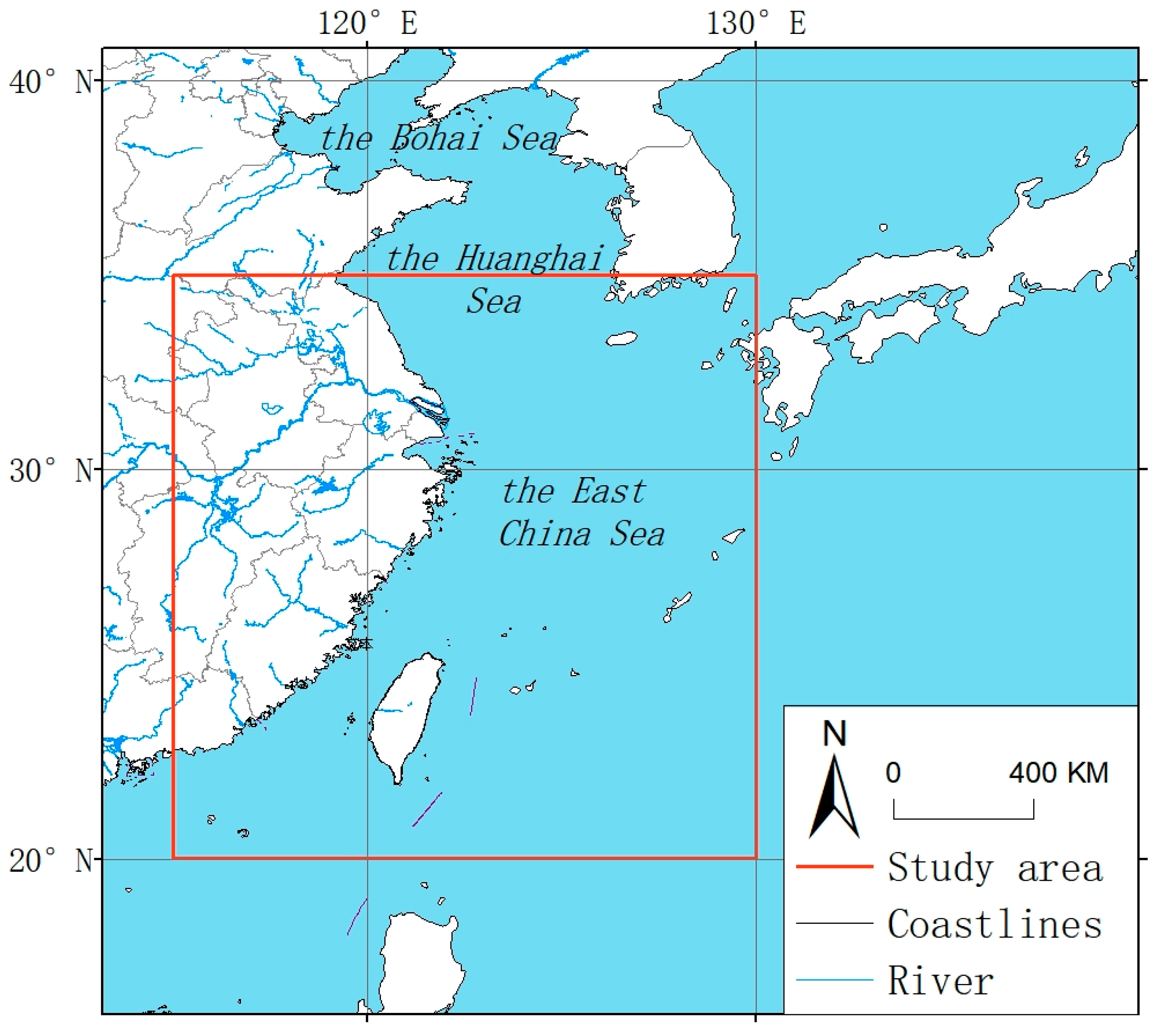

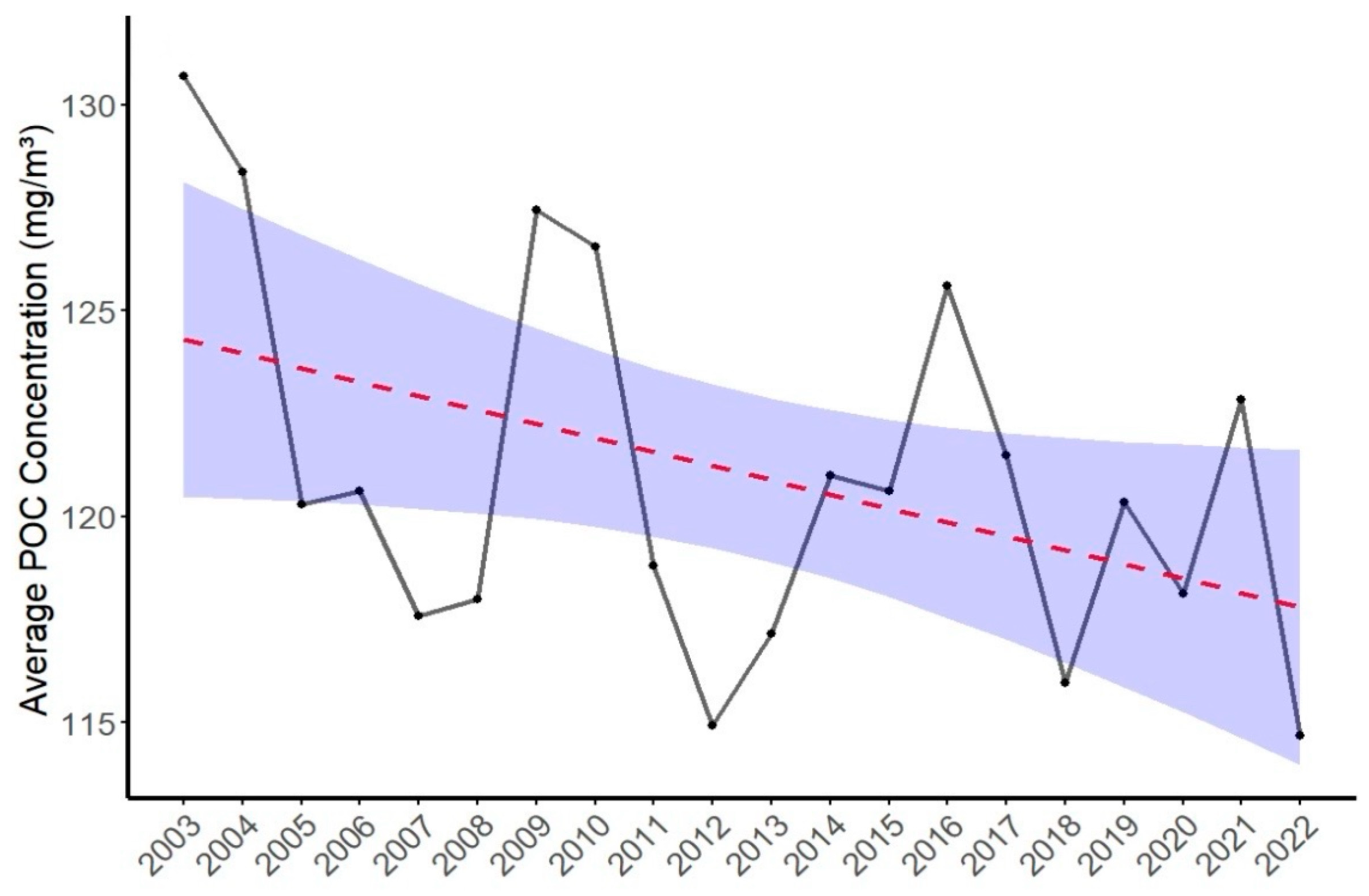
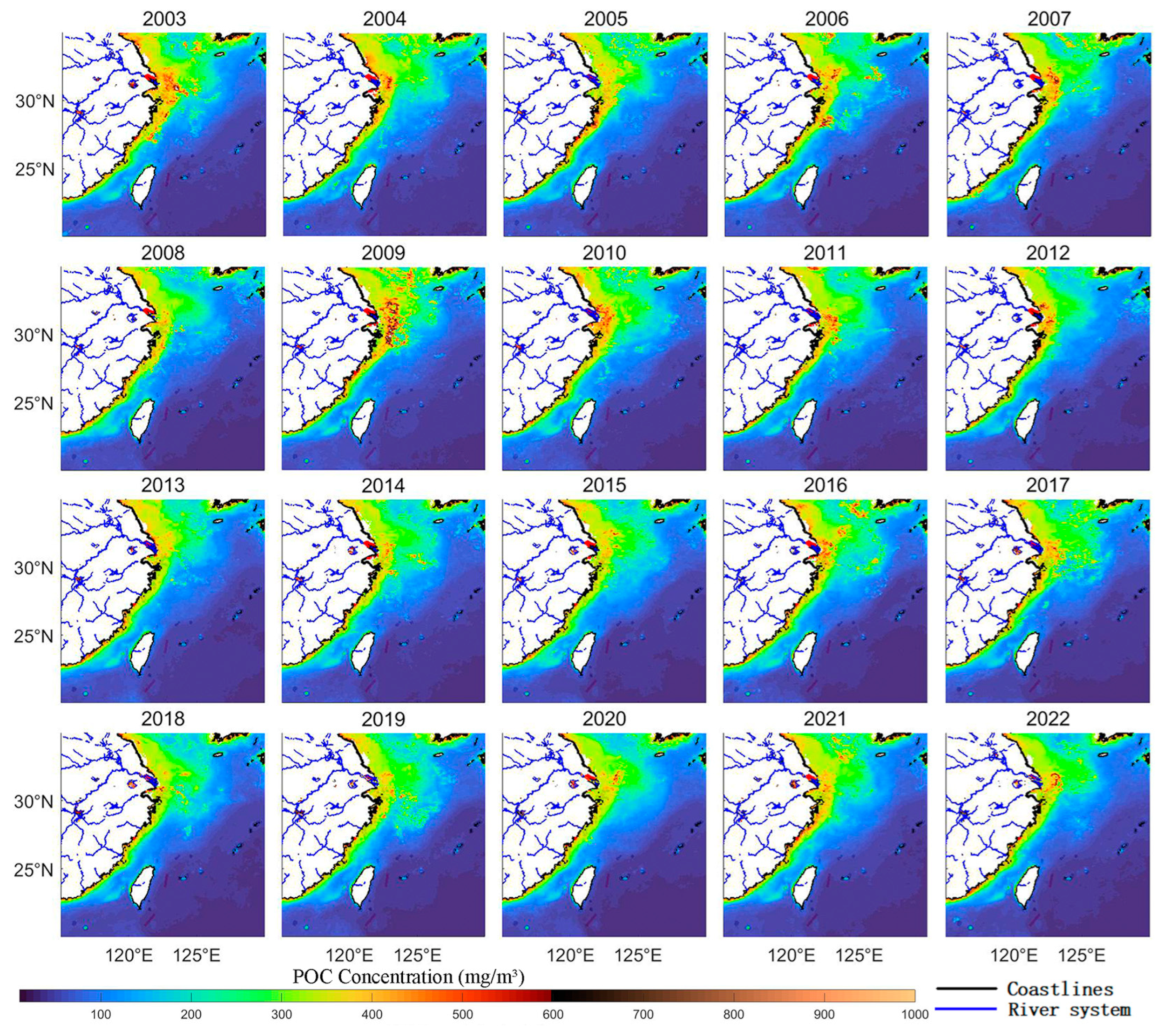
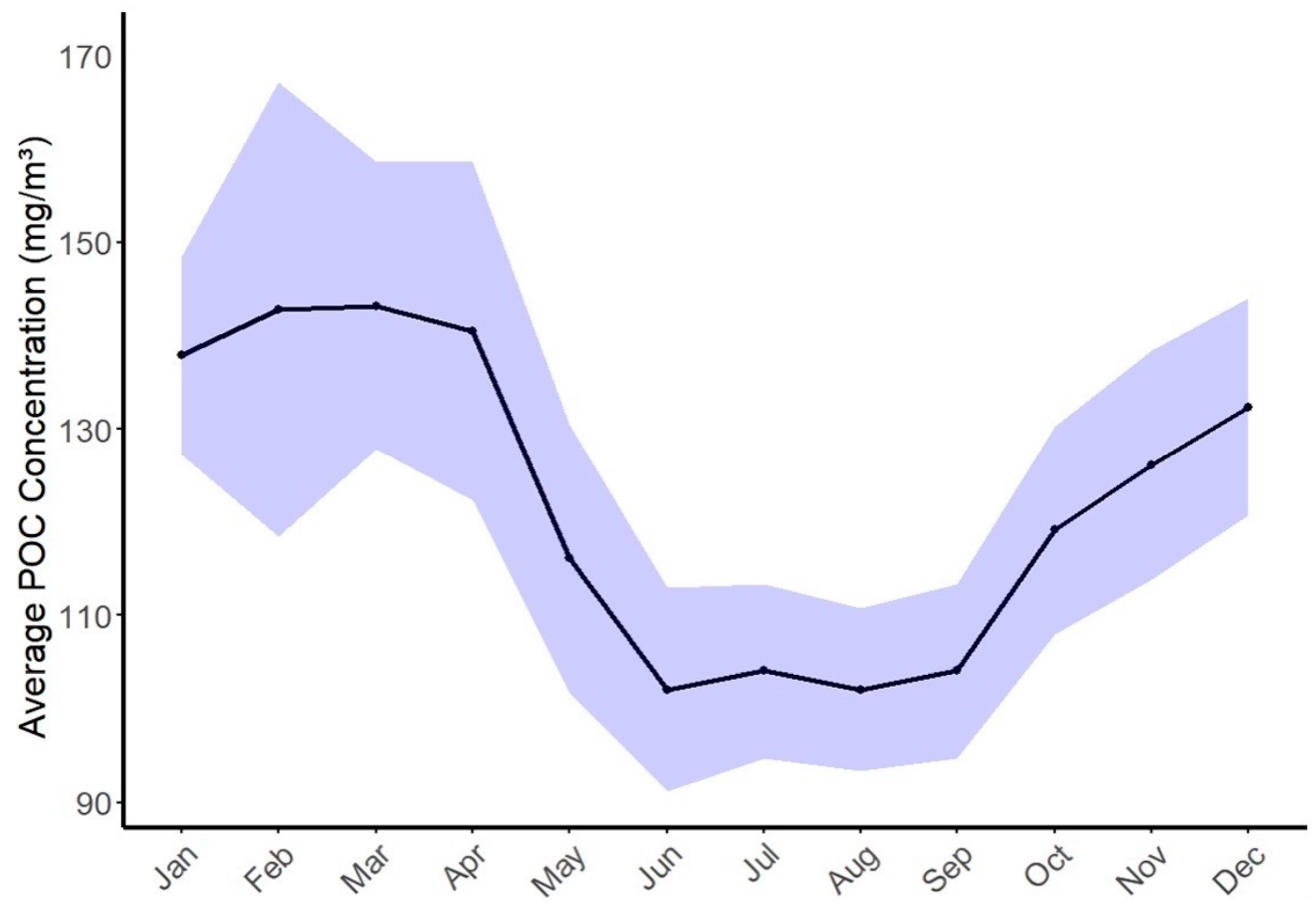

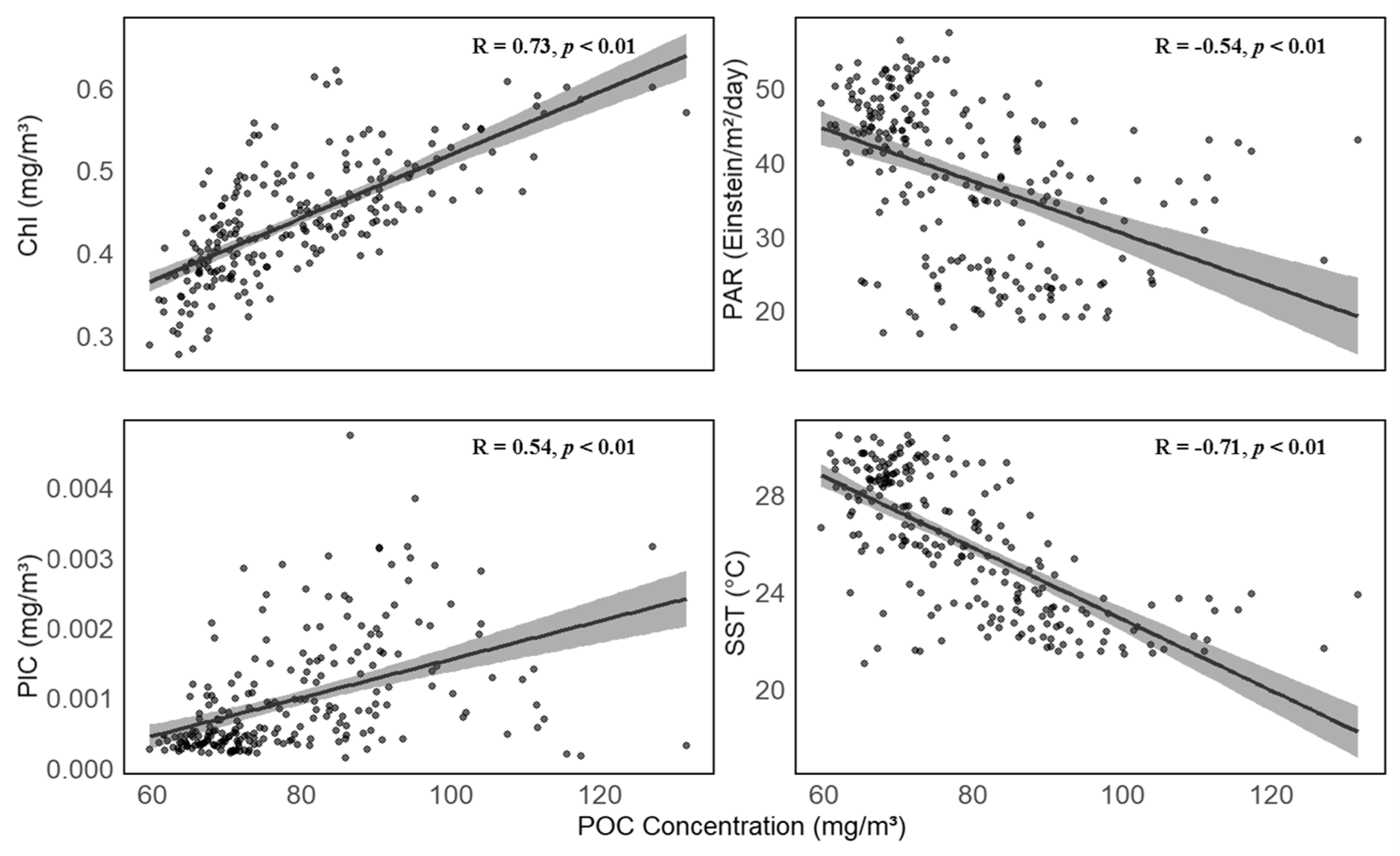

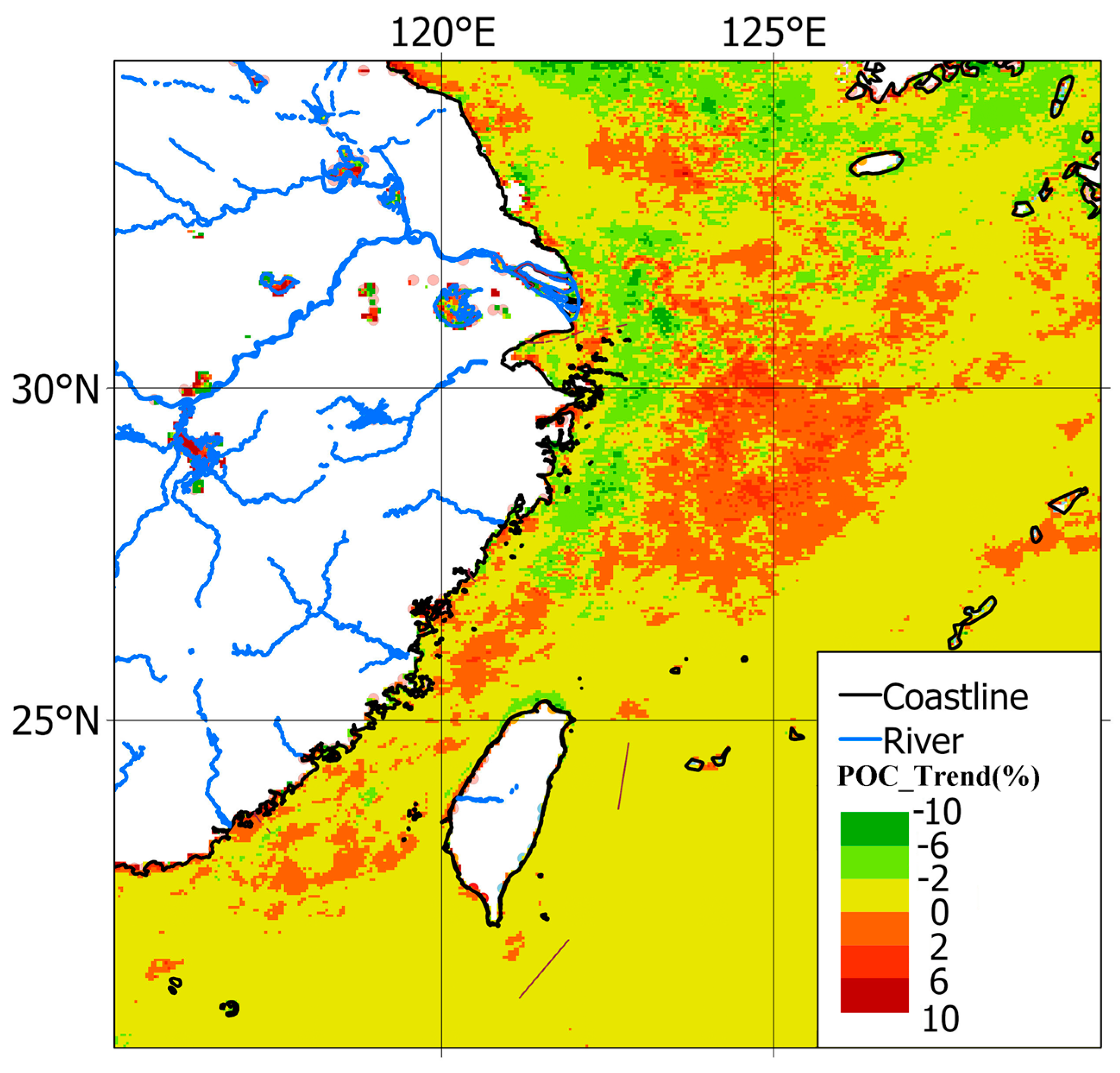
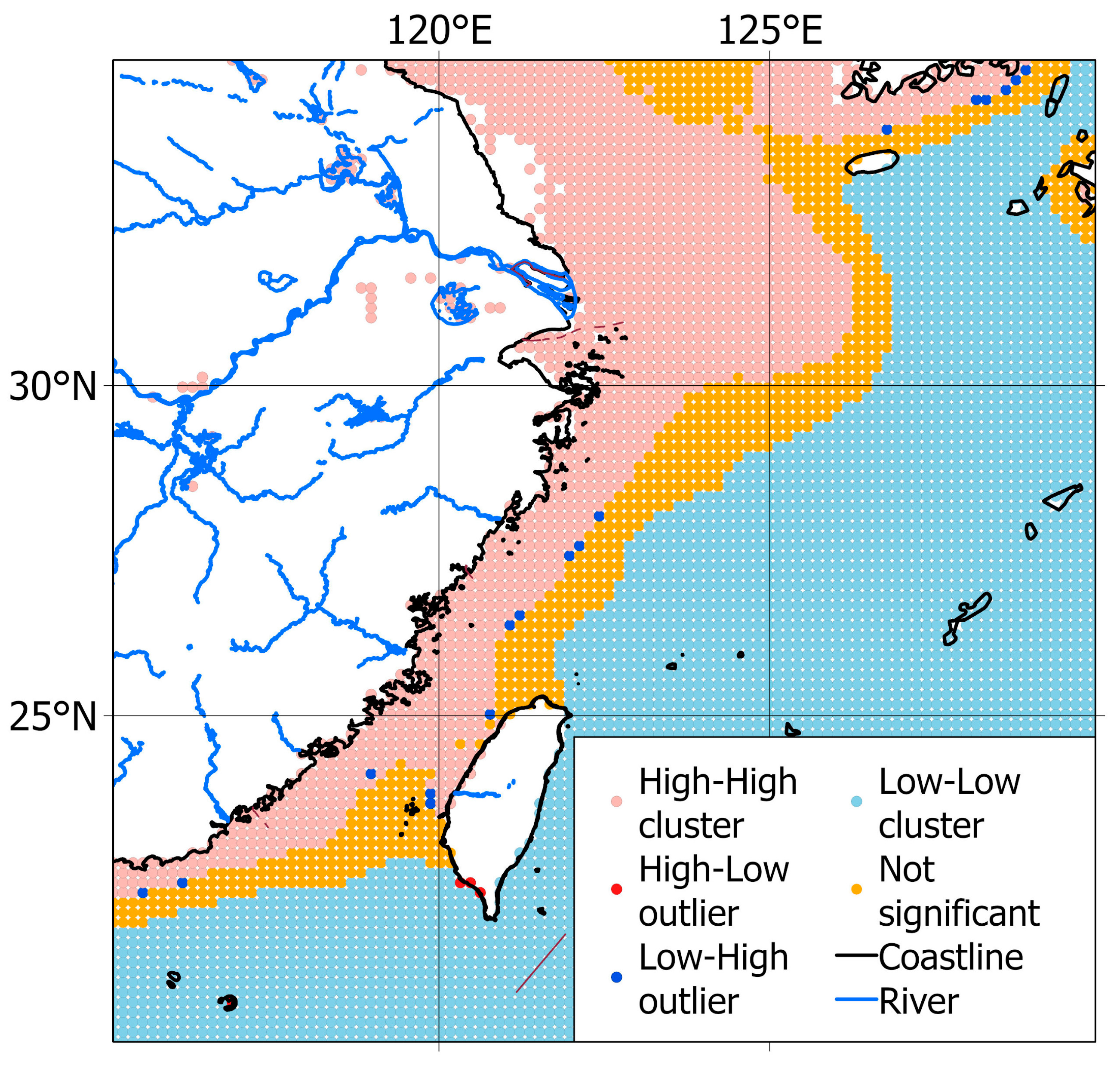
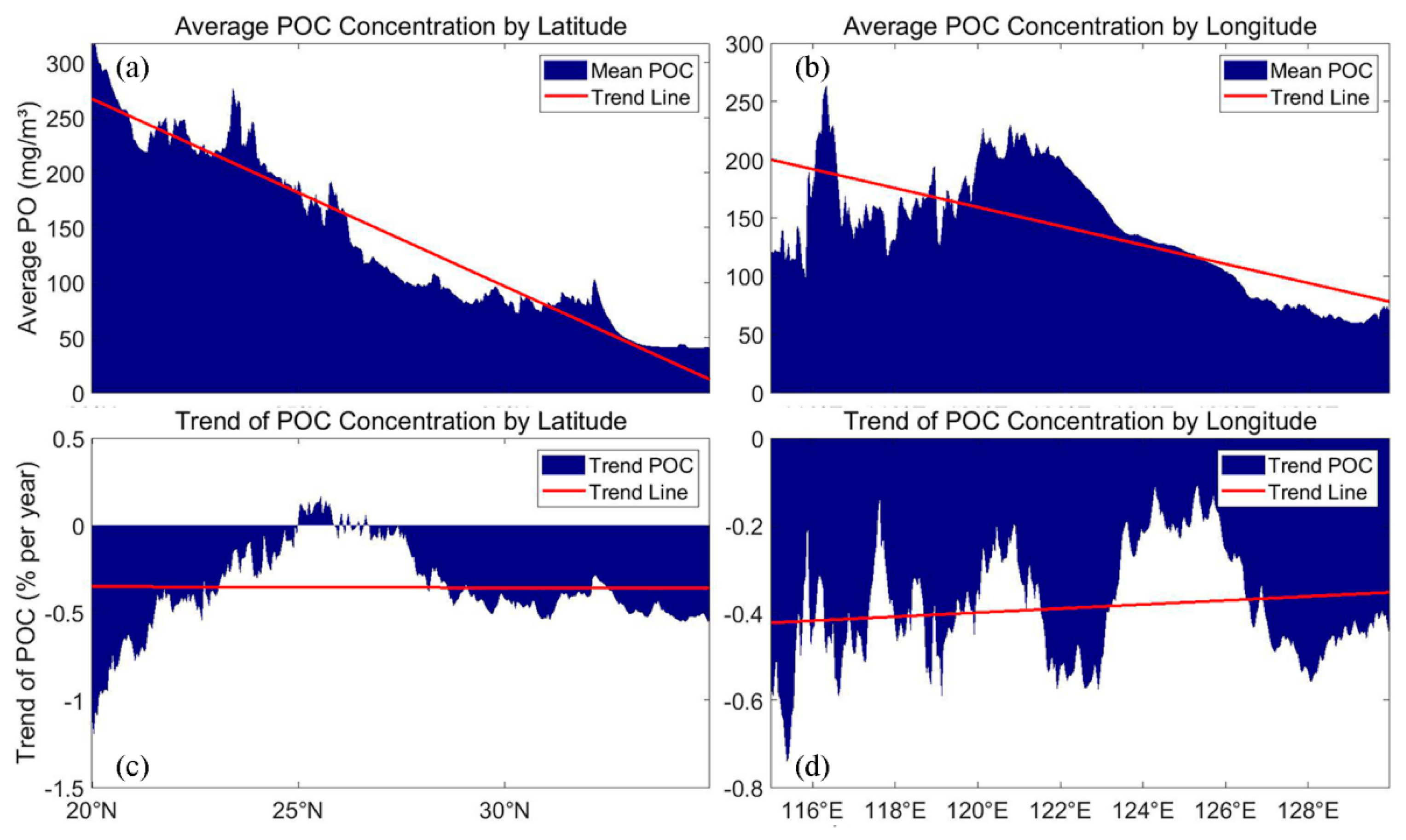
| Variable | Period | Correlation (R) | p-Value | Bootstrap 95% Confidence Interval |
|---|---|---|---|---|
| Chl | 2003–2012 | 0.75 | p < 0.01 | (0.64, 0.77) |
| Chl | 2013–2022 | 0.72 | p < 0.01 | |
| PAR | 2003–2012 | −0.50 | p < 0.01 | (−0.53, −0.33) |
| PAR | 2013–2022 | −0.58 | p < 0.01 | |
| PIC | 2003–2012 | 0.50 | p < 0.01 | (0.30, 0.56) |
| PIC | 2013–2022 | 0.57 | p < 0.01 | |
| SST | 2003–2012 | −0.65 | p < 0.01 | (−0.75, −0.62) |
| SST | 2013–2022 | −0.77 | p < 0.01 |
| Variable | q-Statistic | p-Value |
|---|---|---|
| Chl | 0.84 | p < 0.01 |
| PAR | 0.30 | p < 0.01 |
| SST | 0.64 | p < 0.01 |
| PIC | 0.75 | p < 0.01 |
Disclaimer/Publisher’s Note: The statements, opinions and data contained in all publications are solely those of the individual author(s) and contributor(s) and not of MDPI and/or the editor(s). MDPI and/or the editor(s) disclaim responsibility for any injury to people or property resulting from any ideas, methods, instructions or products referred to in the content. |
© 2025 by the authors. Licensee MDPI, Basel, Switzerland. This article is an open access article distributed under the terms and conditions of the Creative Commons Attribution (CC BY) license (https://creativecommons.org/licenses/by/4.0/).
Share and Cite
Liu, Z.; Chen, Y.; Lin, X.; Yang, W. Spatio-Temporal Dynamics of Particulate Organic Carbon and Its Response to Climate Change: Evidence of the East China Sea from 2003 to 2022. J. Mar. Sci. Eng. 2025, 13, 963. https://doi.org/10.3390/jmse13050963
Liu Z, Chen Y, Lin X, Yang W. Spatio-Temporal Dynamics of Particulate Organic Carbon and Its Response to Climate Change: Evidence of the East China Sea from 2003 to 2022. Journal of Marine Science and Engineering. 2025; 13(5):963. https://doi.org/10.3390/jmse13050963
Chicago/Turabian StyleLiu, Zhenghan, Yingfeng Chen, Xiaofeng Lin, and Wei Yang. 2025. "Spatio-Temporal Dynamics of Particulate Organic Carbon and Its Response to Climate Change: Evidence of the East China Sea from 2003 to 2022" Journal of Marine Science and Engineering 13, no. 5: 963. https://doi.org/10.3390/jmse13050963
APA StyleLiu, Z., Chen, Y., Lin, X., & Yang, W. (2025). Spatio-Temporal Dynamics of Particulate Organic Carbon and Its Response to Climate Change: Evidence of the East China Sea from 2003 to 2022. Journal of Marine Science and Engineering, 13(5), 963. https://doi.org/10.3390/jmse13050963






